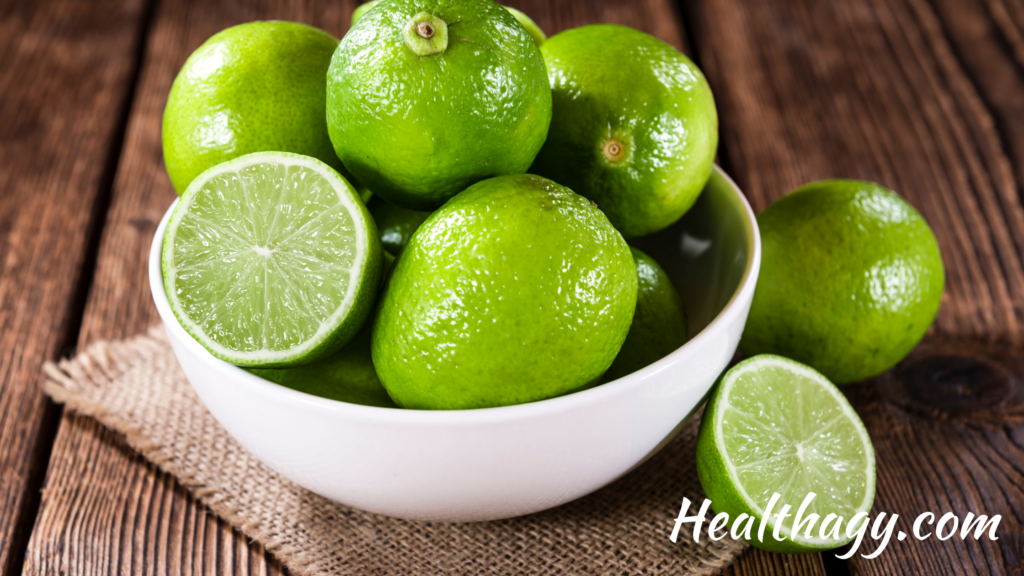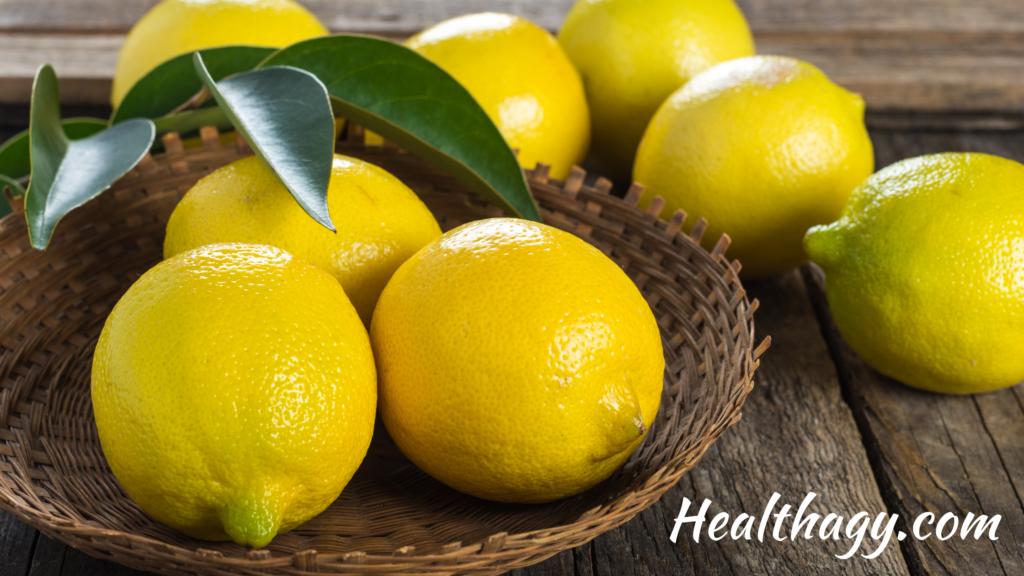
Some people love lemons, some love limes, and others love them both. They are both popular citrus fruits. There can be a lot of debate and confusion on which is healthier, tastier, and if they’re actually the same!
This post will cover everything you need to know about the differences and similarities between limes vs lemons.
Key Differences Lime vs Lemon
The main difference between lime vs lemon is that lemons are slightly sweeter and limes more bitter, while they both have a tart flavor. Lemons are used more in sweet foods and pastries, while limes are used more often in savory dishes, but they can both be found in sweet and savory foods.
Limes are known for their bright green color and lemons for their bright yellow color. Limes tend to be smaller than lemons. Limes are typically more rounded, and lemons are a bit more oblong.

What is a Lime?
Limes are a citrus fruit; although it is closely related to the lemon, they are, in fact, different. The scientific name for lime is Citrus Aurantifolia.
Lime trees are shorter and slimmer, with smaller leaves than lemon trees. Lime trees need a warmer temperature to grow and are best grown in tropical and subtropical climates such as Brazil, Mexico, and other South American countries, as well as southeast Asia.
When it comes to knowing if lime is ripe, did you know a ripe lime is pale green in color or yellow?! Limes are harvested before ripening while they are still green. They are easy to transport and store longer when unripe, which is why we’ve become so accustomed to seeing green limes. If they weren’t shipped until they were ripe, they would likely be over-ripe and spoiled by the time they reached the grocery store and then your home.
Lime Varieties
There are several different varieties of limes, around twenty. The most common types in the United States are the Key lime, Persian lime, and Tahitian limes, among others.
Key limes are a type of Mexican lime and are most notably used in making key lime pie. Key limes are grown in hot climates and grow to about one to two inches in diameter, smaller than many other types of limes. As key limes ripen and become more yellow, they also intensify in flavor, known for their intense sour-sour taste.
A few other Mexican limes are the Mary Ellen sweet limes, Thornless Mexican limes, and the Castello limes. Mexican limes tend to have a strong aroma, a thin rind, and an acidic taste.
Bearss limes are a type of Persian limes that are the most popular type of limes in the world. They are larger than key limes, with a less acidic taste, and are more oval than key limes. They also have a thicker rind than the Mexican limes.
Very similar to the Bearss limes are the Tahiti limes. These two types of Persian limes are the most common types of limes you will find in the grocery store.
Culinary Uses for Limes
Limes are typically less sweet and bitter than lemons, so they have different culinary uses.
Lime juice and lime zest are the main ingredients of lime pie. The rind of lime and its zest can be used as a garnish in many dishes. Lime rinds are also used to infuse vinegar and oils. Mexican cuisine, Thai cuisine, and Vietnamese cuisine are known for including hints of lime or lime juice in several of their dishes.
The lime juice of freshly squeezed lime is my go-to for helping fresh juice to last longer, as it acts as a natural preservative.
While culinary is the most popular way to use limes, there are several other uses of lime, such as in natural cleaning products, cosmetics, and essential oils for medicinal purposes.

What is a Lemon?
Lemons are also a part of the citrus family. The scientific name for lemons is Citrus limon. They have a more sour flavor than limes do. They also taste refreshing, making lemonade and lemon water such a refreshing drink, especially in hot weather.
Lemons are a hardier fruit and can withstand more moderate climates worldwide. The trees can grow to a good size for a fruit tree, with heights reaching around twenty feet.
Lemons are known for their bright yellow color, although underripe lemons can actually be green in color! The shape of a lemon is more oblong and oval in shape than a lime which is more round.
Varieties of Lemons
Like limes, there are a variety of different types of lemons available, about twenty-five different varieties. The most common types of lemons you’ll find are Lisbon, Eureka, and Meyer lemons.
Eureka lemons are a common variety that can be found in grocery stores. They closely resemble Lisbon lemons. Eureka lemons are grown in many countries throughout the world.
The Lisbon lemons are commonly found at the grocery store as well. They have a big “nipple” or a top knot at the top of the lemon. The Eureka lemons have a smaller and less noticeable top knot.
Meyer lemons are typically sold in a bag of about 4-8 lemons and are not always available in the grocery store as they are in season during late winter and early spring. Meyer lemons have a very thin rind and are a favorite for making lemonade and other sweeter drinks and foods due to their sweet, floral flavor.
Culinary Uses for Lemons
Lemons have a variety of uses and can be used in cooking, baking, cleaning, food preservation, and natural beauty products.
Lemons are best known for their lemon zest, made from lemon peel and lemon juice. They can add great flavor to savory dishes and just the right amount of tartness to sweet desserts such as lemon meringue pie.
Not to mention the popularity of lemons in drinks such as lemonade, lemon water, and a variety of cocktails like a lemon drop.
Lemons can also be used for their essential oils in cosmetics and other medicinal purposes. Lemon juice and lemon oil diluted make a natural cleaner as they carry antibacterial properties with a fresh, clean scent!
Health Benefits of Lemons and Limes
The nutritional profile below compares 100 grams of raw lemon to 100 grams of raw lime. For reference, one lemon is about 84 grams on average, and lime is about 67 grams.
| Lemon, raw (100 g) | Lime, raw (100 g) | |
| Calories | 29 | 30 |
| Protein | 1.1 g | 0.7 g |
| Dietary Fiber | 2.8 g | 2.8 g |
| Calcium | 26 mg | 33 mg |
| Iron | 0.6 mg | 0.6 mg |
| Phosphorus | 16 mg | 18 mg |
| Potassium | 138 mg | 102 mg |
| Zinc | 0.06 mg | 0.11 mg |
| Selenium | 0.4 µg | 0.4 µg |
| Vitamin C | 53 mg | 29.1 mg |
| Thiamin | 0.04 mg | 0.03 mg |
| Riboflavin | 0.02 mg | 0.02 mg |
Lemons and limes have a very similar nutritional profiles. The only nutrient that lemons have a significant amount more of is vitamin c content. As a reference point, the recommended daily amount of vitamin C is 75 mg daily for women and 90 mg for men, although this will vary based on age and other factors.
Vitamin C is an antioxidant that helps protect your body from the effects of free radicals. Vitamin C may help to lower the risk of some cancers, but more research is needed. Vitamin C also supports eye health and a healthy immune system.
Lemon water has become increasingly popular these days. There are many health benefits of lemon water, which makes it a popular and easy drink to make. The one thing to note about lemon water and lime water is that it needs to be adequately diluted as concentrated. The acidic acid content can strip away tooth enamel. My dentist also mentioned to me before that it was a good idea to rinse my mouth out with water after drinking lemon water, especially if I brush my teeth after drinking lemon water.
Key Takeaways
Lemons and limes are nutritionally very similar, with lemons being a richer source of Vitamin C. The debate between limes vs. lemons comes down to personal preference and which citrus fruit your taste buds desire- the slightly sweeter taste lemons offer or the more bitter, tart flavor of limes.
Read More:
Juicer vs Vitamix: Which is a Better Buy for Your Health?
3 Delicious Parsley Juice Recipes with Health Benefits
Karla Kueber is a Certified Evidence Based EFT Practioner and Health Coach, with a double Masters Degree in Education. She works with people to overcome emotional eating, curb cravings, and overcome resistance to eating new healthy foods. You can learn more about coaching with her here.